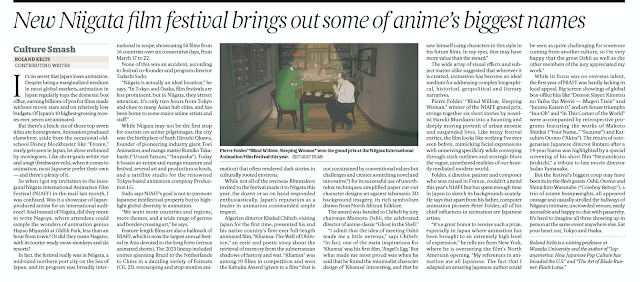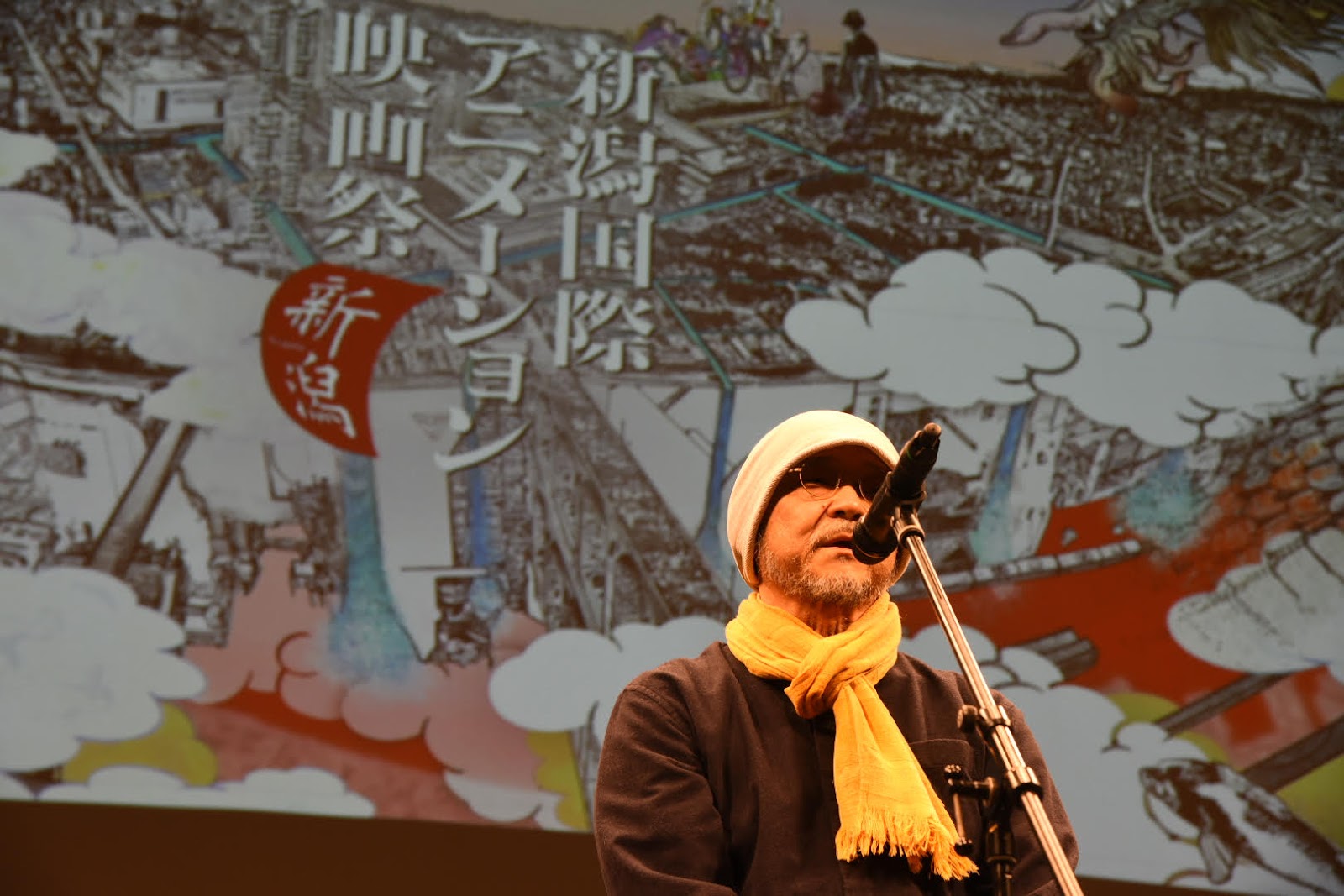When Katsuhiro Otomo (Akira), Mamoru Oshii (Ghost in the Shell) and Shinichiro Watanabe (Cowboy Bebop) show up in the same small venue in the same small city on the Sea of Japan--magic happenstances. I was invited to attend the first annual Niigata International Animation Festival and I'm glad I went. My take below.
New Niigata film festival brings out the big names in anime
 |
| Roland Kelts JAPAN TIMES column CULTURE SMASH |
It’s no secret that Japan loves animation. Despite being a marginalized medium elsewhere, animation in Japan regularly tops the domestic box office, earning billions of yen for films made without movie stars and on relatively low budgets. Of Japan’s 10 highest-grossing movies ever, seven are animated.
But there’s a hitch: six of those top seven titles are homegrown. Animation produced elsewhere, aside from the occasional old-school Disney blockbuster like “Frozen,” rarely gets seen in Japan, let alone embraced by moviegoers. Like short-grain white rice and unagi (freshwater eels), when it comes to animation, most Japanese prefer their own — and there’s plenty of it.
So when I got my invitation to the inaugural Niigata International Animation Film Festival (NIAFF) in the mail last month, I was confused. Was it a showcase of Japan-produced anime for an international audience? And instead of Niigata, did they mean to write Nagoya, where attendees could sample the wonders of animation genius Hayao Miyazaki at Ghibli Park, less than an hour from town? Or did they mean Nagano, with its tourist-ready snow monkeys and ski resorts?
In fact, the festival really was in Niigata, a mid-sized northern port city on the Sea of Japan, and its program was broadly international in scope, showcasing 50 films from 16 countries over six consecutive days, from March 17 to 22.
None of this was an accident, according to festival co-founder and program director Tadashi Sudo.
“Niigata is actually an ideal location,” he says. “In Tokyo and Osaka, film festivals are less prominent, but in Niigata, they attract attention. It’s only two hours from Tokyo and close to many Asian hub cities, and has been home to some major anime artists and staff.”
Tadashi Sudo
While Niigata may not be the first stop for tourists on anime pilgrimages, the city was the birthplace of both Hiroshi Okawa, founder of pioneering industry giant Toei Animation, and manga master Rumiko Takahashi (“Urusei Yatsura,” “Inuyasha”). Today it boasts an anime and manga museum and festival, several art and production schools, and a satellite studio for the renowned Tokyo-based animation company Production I.G.Sudo says NIAFF’s goal is not to promote Japanese intellectual property but to highlight global diversity in animation.
“We want more countries and regions, more themes, and a wide range of genres and border-crossing art,” he says.
Feature-length films are also a hallmark of NIAFF, which is now the largest annual festival in Asia devoted to the long form (versus animated shorts). The 2023 lineup included entries spanning Brazil to the Netherlands to China in a dazzling variety of formats (CG, 2D, rotoscoping and stop-motion animation) that often rendered dark stories in culturally rooted environs.
Khamsa
Not all of the overseas filmmakers invited to the festival made it to Niigata this year, but the dozen or so on hand responded enthusiastically. Japan’s reputation as a leader in animation commanded ample respect.
Algerian director Khaled Chiheb, visiting Japan for the first time, presented his and his native country’s first-ever full-length animated film,
“Khamsa: The Well of Oblivion,” an eerie and poetic story about the retrieval of memory from the subterranean shadows of history and war. “Khamsa” was among 10 films in competition and won the Kabuku Award (given to a film “that is not constrained by conventional values but challenges and creates something novel and innovative”) for its successful use of unorthodox techniques: simplified paper cut-out character designs set against talismanic 3D background imagery, its rich symbolism drawn from North African folklore.
The award was handed to Chiheb by jury chairman Mamoru Oshii, the celebrated director of anime classic “Ghost in the Shell.”
Mamoru Oshii
“I admit that the idea of meeting Oshii made me a little nervous,” says Chiheb. “One of the main inspirations for ‘Khamsa’ was his first film, ‘Angel’s Egg.’ But what made me most proud was when he said that he found the minimalist character design of ‘Khamsa’ interesting, and that he saw himself using characters in this style in his future films. In my eyes, that may have more value than the award.”
The wide array of visual effects and subject matter alike suggested that wherever it is created, animation has become an ideal medium for addressing complex biographical, historical, geopolitical and literary narratives.
Pierre Foldes’
“Blind Willow, Sleeping Woman,” winner of the NIAFF grand prix, strings together six short stories by novelist Haruki Murakami into a haunting and deeply moving portrait of urban anomie and suspended lives. Like many festival entries, the film looks like nothing I’ve ever seen before, mimicking facial expressions with unnerving specificity while conveying through stark outlines and strategic blurs the vague, untethered realities of our heavily mediated modern world.
"Blind Willow, Sleeping Woman"
Foldes, a director, painter and composer who was raised in France, couldn’t attend this year’s NIAFF but has spent enough time in Japan to sketch its backgrounds acutely. He says that apart from his father, computer animation pioneer Peter Foldes, all of his chief influences in animation are Japanese artists.
“It’s a great honor to receive such a prize, especially in Japan where animation has been brought to an extremely high level of expression,” he tells me from New York, where he is overseeing the film’s North American opening. “My references in animation are all Japanese. The fact that I adapted an amazing Japanese author could be seen as quite challenging for someone coming from another culture, so I’m very happy that the great Oshii as well as the other members of the jury appreciated my work.”
Prize-winning international directors with Oshii in Niigata.
While its focus was on overseas talent, the first year of NIAFF was hardly lacking in local appeal. Big-screen showings of global box-office hits like “Demon Slayer: Kimetsu no Yaiba the Movie — Mugen Train” and “Jujutsu Kaisen 0,” and art-house triumphs “Inu-Oh” and “In This Corner of the World” were accompanied by retrospective programs featuring the works of Makoto Shinkai (“Your Name.,” “Suzume”) and Katsuhiro Otomo (“Akira”). The return of octogenarian Japanese director Rintaro after a 14-year hiatus was highlighted by a special screening of his short film “Nezumikozo Jirokichi,” a tribute to late movie director Sadao Yamanaka.


Otomo (Akira), Watanabe (Cowboy Bebop), Ohshii (GiTS)
But the festival’s biggest coup may have been its in-the-flesh guests. Oshii, Otomo and Shinichiro Watanabe (“Cowboy Bebop”), a trio of anime heavyweights, all appeared onstage and casually strolled the hallways of Niigata’s intimate, uncrowded venues, easily accessible and happy to chat with passersby. It’s hard to imagine all three showing up in person at the same event anywhere else. Eat your heart out, Tokyo and Osaka.










.jpg)